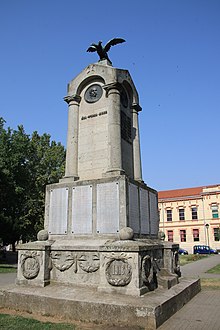François Léon Jouinot-Gambetta
During the First World War he commanded a cavalry brigade on the Macedonian front and was responsible for a rapid advance that captured Skopje from the Bulgarians.
[4]: 20 Jouinot-Gambetta transferred to the 9th Regiment of Hussars on 18 August 1893, becoming an officer cadet in addition to his role as maréchal des logis.
The sheikh later rose in revolt and was defeated by French troops under General Charles Emile Moinier at Fez on 23 June 1910.
[4]: 19 Upon his return to France Jouinot-Gambetta was appointed to a position at the Ministry of Foreign Affairs, specialising in ordnance.
He had responsibility for drawing up that years promotion lists and admitted favouring his old Jesuit college friends who he thought had been disadvantaged by the actions of the anti-clerical ministry of Louis André.
[4]: 20 British military historian Cyril Falls has described Jouinot-Gambetta as "a hard bitten, hard-drinking Frenchman with an immortal name".
[4]: 1 In 1917 Jouinot-Gambetta was appointed to command a brigade of three regiments of Spahis and Chasseurs d'Afrique with the Armée d'Orient on the Macedonian front.
[1][7] In late September General Louis Franchet d'Espèrey ordered Jouinot-Gambetta to advance on Skopje during the Vardar Offensive.
Jouinot-Gambetta led his brigade into the midst of a retreating mass of Bulgarians, navigating pockets of resistance from German troops.
[1] On 12 October 1930, the Monument to the liberators and General Gambetta (Spomenik oslobodiocima i generalu Gambeti u Negotinu [sr]) was unveiled in Negotin, Serbia (then Kingdom of Yugoslavia) in the presence of Jouinot-Gambetta's widow Blanche Augustine Haÿ.


